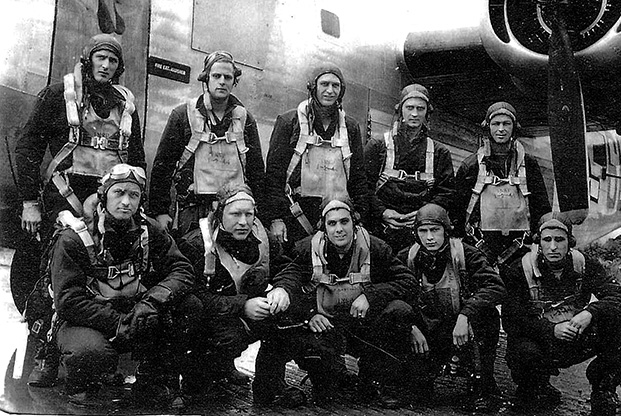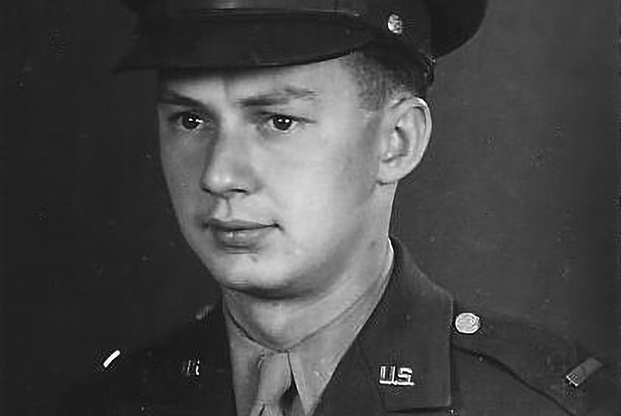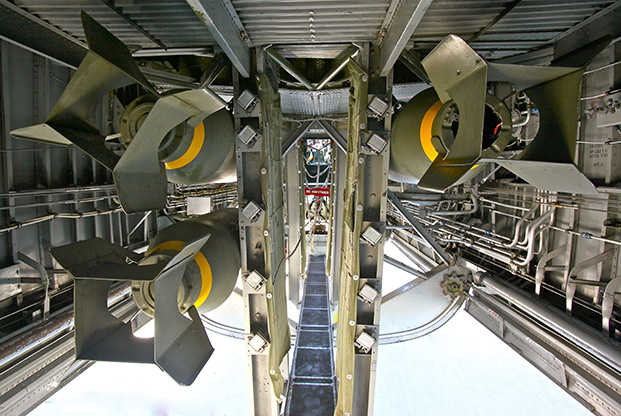
Crew 704 completed 30 missions. It was the third mission (and Gulick’s first) that tested their wits. Photo: American Air Museum in Britain
Laurence “Ray” Gulick joined the Army Air Forces and graduated from bombardier training in August 1943. Assigned to B-24s, he was in Crew 704, 787th Bomb Squadron, 466th Bomb Group. In February 1944, they deployed with the Eighth Air Force to Attlebridge, England. At the time, there were 60 bases in England and approximately 40 bombers per base.
Gulick’s first flying mission was on March 27, 1944.

2nd Lt. Laurence Gulick. Photo: American Air Museum in Britain
THE MISSION
Crew 704 was assigned to fly over Biarritz, France, and the Bay of Biscay, where they were ordered to release their payload on an advanced pursuit field with the goal of hitting the barracks. The B-24 was capable of carrying 8,000 pounds of explosives, but there were only 20 shackles to suspend the bombs in the bomb bay. When loaded with 100-pound bombs, the aircraft was only carrying 2,000 pounds.
The Liberator could carry a lot more weight, so that day, the armorers decided to expand the number of munitions that would be carried on the mission. In the true spirit of American ingenuity, they jury-rigged extra bombs on top of the standard 20 shackles and used wire to attach additional bombs on the stations. This gave each aircraft 40 bombs—double the load they were meant to carry, but still well within the weight capacity of the aircraft.
Each bomb had a propeller. When the bomb was latched into the bomb bay, a wire kept the propeller from turning. Once the bomb dropped a certain distance—normally no more than six inches—the wire came out and air would turn the propeller. After a number of revolutions, the bomb was armed, and any contact with the nose fuse after that detonated the bomb.
Once all of the bombs had been loaded and flight checks were complete, 30 B-24s took off for France.Not a single man knew that they were flying into a nightmare. ?

The catwalk on the B-24 was nine inches wide, leaving little margin for error when handling live bombs hung up in flight. Photo: Steve Jurvetson
IN-AIR NIGHTMARE
At 16,000 feet over the target, they began to release their weapons. However, Gulick noticed lights indicating that some bombs had not released. Gulick and the tail gunner, Sgt. Donald J. Waddle, went onto the catwalk to investigate. Three bombs were hung up. On top of them were four bombs that were lodged against the side of the aircraft. The wire had been pulled from the nose of the bombs, and the propellers had fallen off.
The bombs were hot.
Gulick went into survival mode. If he and Waddle did not act quickly, the bombs would detonate on board, and the crew and aircraft would be lost. They had to get rid of the bombs, and the only way to do it would be to jettison them by hand.
Only nine inches wide and without a side railing, he and Waddle had little room to be maneuver 100-pound live bombs. To make matters worse, crew members needed to wear oxygen masks above 10,000 feet, but the catwalk was too narrow to accommodate the masks and hosing. They would have to continue without oxygen.
The pilot descended to 13,000 feet, and with the bomb bay doors open, surrounded by deathly cold air, Gulick and Waddle carefully picked up the hot bombs one at a time. The propellers had already fallen off so if the nose of the bomb was touched, it would detonate. They had to lift each bomb with just the tips of their fingers, with Waddle at the back and Gulick at the front. Failure to coordinate the drop could force the other person off the catwalk. Any wrong move could set the bomb off.
TIME TO WAKE UP
Each bomb took about 15 minutes to remove. Every bomb jettisoned was a bomb that would not fall on target, but also a bomb that would not take the lives of the crew on board. Once the bombs had been safely evacuated from the aircraft, they triggered the release mechanism on the three bombs that were hung up, and they fell by themselves.
The entire mission took eight hours.
It was Gulick’s first mission, and it had been horrifying. There were 29 more to go. During every mission that followed, this was the one that hung in the back of his mind. Thankfully, he never faced this situation again.
Many of the other Liberators flying over Biarritz, France, that day encountered other difficulties. The B-24s were never again manipulated to hold double the intended payload.
Had it not been for the quick thinking of Gulick and Waddle— and had they not been able to stay calm under pressure—the entire crew would have lost their lives.
Gulick went on to complete his 30 missions. During the last one, three of his crew members were wounded, and one was killed. In August 1944, he and the surviving crew returned to the states. He went on to train other young men to be bombardiers. In 1948, he transferred into the Air Force Reserve where he served for another 20 years, while in his civilian career, he served as a precision aerial photographer. He retired as a major in 1968 after serving 26 years, accruing 8,000 flying hours in over 40 types of aircraft.